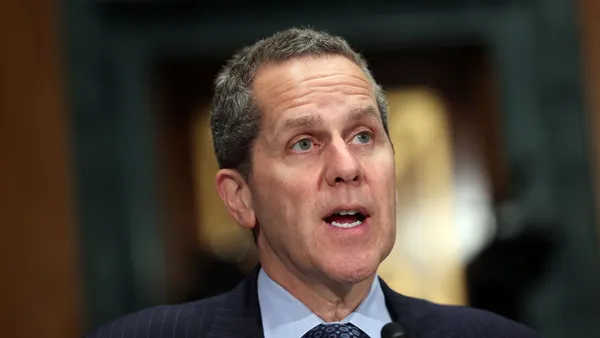NEW YORK — Clear boundaries in a partnership between a bank and a fintech company can help foster innovation, determine regulatory responsibility and put customers at ease, panelists said Tuesday at an annual conference hosted by The Clearing House and the Bank Policy Institute.
To illustrate their point, panelists cited two recent diametrically opposed examples. In revealing a plan to offer checking accounts backed by Citi, a Google executive said the company would "partner deeply with banks and the financial system" and rely on its partners for regulatory compliance. Google’s brand would not be front and center on the accounts — instead, its partners’ would be.
Apple, on the other hand, drew the ire of its partner Goldman Sachs when it hyped the Apple Card, which launched in August, as "created by Apple, not a bank."
"Goldman is still taking on the risk" in the project, Peter Davey, head of product innovation at The Clearing House, said Tuesday.
Goldman Sachs CEO David Solomon last month called Apple Card the "most successful credit card launch ever," though its lending algorithm came under fire last week over allegations of gender discrimination.
Bank and fintech partners can look at their relative proximity to users for a clue as to respective liability. If the bank is more of an arm’s-length facilitator and the fintech has a closer relationship with customers, the fintech may find itself on the hook, Davey said.
"But that stratification is going to become more blurry over time," he said.
Indeed, some arm’s-length partners still face scrutiny when consumers are harmed. Lawmakers in August sought to designate cloud providers Amazon Web Services (AWS), Microsoft Azure and Google Cloud as "systemically important" in the wake of a Capital One breach that exposed 106 million customers’ data. Capital One data is stored on AWS’s public cloud, but AWS distanced itself from the scandal.
The dividing line between who does what in a partnership can vary. Concepts such as banking as a service are not new, said Radha Suvarna, managing director and head of digital payments and lending at Citi. "But the evolution is [new] — and [it’s] at a scale we haven't seen," he said.
Boundaries can bring clarity to customers and businesses, but they can also drive innovation because they lay out a delineation of expectations, Suvarna said.
Still, customers will adopt change without guidance from regulators, the panelists said.
"As fintech solutions get deeper and more plentiful, [financial institutions] need to make sure customers understand who has access to their data, know who’s doing what," said Rob Pugh, deputy general counsel for technology and intellectual property at PNC. "If you open up the terms of service, you might give up halfway through. The responsible solution is to make sure the consumer is informed."
Occasionally, businesses need to be put at ease, too, said Jackie Nugent, assistant vice president of the Federal Reserve Bank of Kansas City. She cited some community banks among financial institutions that may be reluctant to embrace change and suggested breaking down terms like "fintech."
"Financial technology at financial institutions is just technology — just like Chinese food in China is just food," she said.
However, Nugent added she has noticed an uptick in her region’s involvement in fintech, citing Wyoming’s special-purpose depository charter.
"A couple of years ago, we might have just said we were leaning in on fintechs," she said. "Now it’s more that we’re being pulled in."














